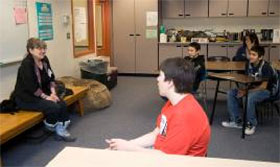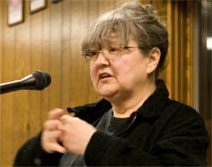Monthly Report to the Dean - January 2009
Announcements:
Marilyn Sigman is joining the Marine Advisory Program faculty as our new Marine Education Specialist. Marilyn will coordinate COSEE Alaska, a new collaborative initiative funded by the National Science Foundation to establish a Center for Ocean Science Education Excellence. Thanks to Reid Brewer for doing an excellent job chairing this committee. Marilyn will begin work on March 16th.
Bree Witteveen has joined MAP as a post-doc, working on the GAP predator-prey research program directed by Kate Wynne. Bree’s research is on the ecology, conservation, and management of humpback and other whales in the western Gulf of Alaska.
Alaska Sea Grant has received 33 preproposals for the 2010-2012 research funding cycle. We will review them on February 20th and invite a subset to submit full proposals. Several of the ASG Advisory Committee members will be participating in the review.
Kate Wynne is in Senegal for three weeks, as part of an international NOAA effort to train marine mammal observers. This is Kate’s second trip – last year she trained observers in Ghana.
Upcoming:
- HACCP, Sanitation and Better Process Control School, Anchorage, February 9-14.
- Tuesdays – FishBiz Workshop Series, Distance Delivered on UATV, link via the MAP website to participate in any of these and see the series outline.
- Community Quota Entity technical workshop, Anchorage, February 17-18.
- ASG preproposal review committee meeting, Anchorage, February 20.
- A Sustainable Future: Fish Processing Byproducts, Portland, Oregon, February 25-26. http://seagrant.uaf.edu/conferences/2009/byproducts/index.html
- Biology and Management of Exploited Crab Populations under Climate Change, 25th Lowell Wakefield Fisheries Symposium, Anchorage, March 10-13. http://seagrant.uaf.edu/conferences/2009/byproducts/index.html
- Panel of 1989 ASG Legal Research Team, at Partners in Prevention, Anchorage, March 24. Reception at the Hilton, March 23.
- UAF Western Alaska Interdisciplinary Science Conference, Energizing Our Future, Nome, April 6-10. http://www.uaf.edu/waisc/
- Alaska Young Fishermen’s Summit III, Anchorage, December 7-9.
Highlights from January:
Ecosystems and Habitats
At the Alaska Marine Mammal Stranding Network annual meeting in Seward, Gary Freitag presented the 2008 activity report for the southern Southeast area and gave a talk on the disentanglement of a humpback whale near Metlakatla. He was also trained in safe handling of marine mammals during necropsies and prevention of exposure to pathogens. Gary, Kate Wynne and Reid Brewer are all members of the Stranding Network.
Coastal Communities and Economies
As a follow-up to the December Latino entrepreneur training, Quentin Fong assisted a family in getting insurance, licensing, and DEC certificates, and helped with cost and pricing. As a result, Maria’s Place food kiosk will open for business in Kodiak February 15.
Heidi Herter has developed a new partnership with Joni Earp-Ahmasuk of the Nome Eskimo Community to establish a swimming/marine safety program for middle school students. This part of Alaska has one of the highest small boat drowning rates in the nation.
Kanektok River Adventures is the name for the archaeological/ecotourism camp near Quinhagak. Terry Reeve continues work with Bethel Americorps, Quinhagak Village Corporation, and Coastal Villages Resource Fund to open the camp in 2009.
At a 3 day workshop to help candidates write proposals for AFN (Alaska Federation of Natives) marketplace grants, one-on-one tutoring was provided by Terry Reeve and others to nine people submitting proposals.
Fisheries
Ben Daly, Sea Grant researcher based in Seward, has been caring for 4 blue king crab and 20 red king crab broodstock in Seward for the AKCRRAB project. Based on eyespots, blue king crabs are expected to hatch in February, and red king crab may hatch in mid March. Larval rearing experiments are planned for the hatchlings. About 300 blue king crab juveniles will be shipped to UAF in Juneau for graduate student research projects.
Torie Baker was re-elected to a third three-year term on the Copper River/PWS Fish and Game Advisory Committee. She was elected as fisheries chair after serving six years as committee secretary.
Glenn Haight taught 2 sessions of the UATV FishBiz Workshop Series – basics of financial management and determining profits and value. 46 people are registered.
Heidi Herter facilitated distance delivery of a North Pacific Fisheries Management Council meeting in Nome discussing chinook salmon bycatch in the pollock fishery. Attendees included 33 local people and 12 from village sites.
Heidi Herter made an AKCRRAB/Little Diomede Crab presentation to the Rotary club in Nome to 25 people.
Terry Reeve is helping Bethel entrepreneur Fran Reich start a small value-added fish production business.
Seafood Processing and Technology
Quentin Fong was an invited panel participant for the session Putting Fish on the Table, at the meeting An Ocean Forum for Haida Gwaii in Skidegate, British Columbia. He also presented a 4 hour workshop, We Are All Niche Marketers Now: The Process of Product Differentiation, and conducted one-on-one consultations. Nineteen participants included bakery owners, museum staff, seafood processors, Native product producers, Visitor’s Bureau staff, and jewelry makers.
Chuck Crapo is teaching sections of the FITC Seafood Processing and Preservation Class (FSN661).
Chuck Crapo has been assisting Alaska processors in product development—salmon jerky manufacturing in Homer and Soldotna, Iditarod dog food packets in Juneau, pasteurization of salmon products in Anchorage, and drying pollock and cod in Kodiak and Dutch Harbor. Also he is helping to develop processes for pouched beef and HACCP.
After Chuck Crapo had discussions with DEC about conflicting regulations on shelf stable seafood products, they agreed that processors should report either water phase salt or water activity, not both.
Marine Literacy and Education
Marla Brownlee led an Alaska Seas and Rivers curriculum trainer workshop in Anchorage. Participants were Pam Garcia and Paula Savikko, Juneau School District; Allen Marquette, Prince William Sound Science Center; Scott McKim, Anchorage School District; Sherri Pristash, ASG; Carol Scott, Fairbanks School District, Terry Slaven, Mat-Su School District; and Katie Villano, Center for Alaskan Coastal Studies. Eight leaders are now prepared to conduct teacher workshops for the curriculum. The first workshop will be held in Juneau on February 16.
Alaska Sea Grant sponsored two student awards for posters at the Alaska Marine Science Symposium. Mayumi Arimitsu, advised by Nicola Hilgruber, won the M.S. poster award, and Nathan Stewart, who studies sea otters with advisor Brenda Konar, won the Ph.D. poster award.
Deborah Mercy was a speaker at the Alaska Marine Science Symposium Communicating Ocean Science workshop, sponsored by COSEE Alaska. Marla Brownlee presented the Alaska Seas and Rivers curriculum at the workshop on behalf of Alaska Sea Grant.
ASG helped produce a one-page announcement to recruit graduate students for the UAF MESAS (Marine Ecosystem Sustainability in the Arctic and Subarctic, http://www.sfos.uaf.edu/mesas/) program, an interdisciplinary NSF project that will support up to 19 students over 4 years.
Reid Brewer wrote the newspaper article: Coastal communities perceive climate changes. It was published in the Dutch Harbor Fishermen, the Cordova Times and the European Project on Ocean Acidification http://oceanacidification.wordpress.com/2008/12/26/what-do-we-know-about-climate-change/
Part of teaching the distance delivered UAF course MSL111, The Oceans, Heidi Herter completed a unit on marine ecosystems, focusing on the effects of climate change on food webs in the Bering Sea. She has 10 students, high school seniors and adults working on associate degrees, all participating from five villages outside of Nome.
Heidi Herter and others hosted three IPY speakers recently in Nome: Craig George, wildlife biologist with the North Slope Borough, spoke on integrating traditional knowledge with management for a better bowhead-counting system in Barrow. Lee Cooper, research professor at the University of Maryland, spoke on the effects of declining ice on the Bering Sea ecosystem. Ernestine Hayes, UAS writing professor, spoke on “What shall we do with our histories?”


Rapid Response
ASG publications distributed in the highest numbers in January were the 2009 Alaska Sea Grant Catalog • Seafood Safety: What Consumers Need to Know • 2009 Alaska Coastal Calendar • Care and Handling of Salmon • Marine Habitat Mapping Technology for Alaska. People who recently ordered publications from ASG cited the following uses: Trashing Your Livelihood: “Show to those at work involved in fisheries. I work at the 17th Coast Guard District in Juneau.” • Air Shipment of Fresh Fish, Recoveries and Yields, Care and Handling of Salmon, and Factors Affecting Quality of Rock Sole: “I am a fishing engineer and I would like to use these publications in the university. I want to highlight that there are no similar publications in Argentina, so this material will be very useful to teach.” • Fishermen’s Direct Marketing Manual: “I plan on direct marketing a small amount of catch.” Idaho. • The Business of Fishing: Managing Finances: “I plan to use it as a guide. I am new at owning my own fish plant and can use all the help I can get.”
MAP agents responded to the following requests: assisted Native corporation staff investigate personal care products development and labeling, and the use of seafood oil ingredients; reviewed proposal ideas with local seafood processor and Chuck Crapo for documenting summer seafood processing and production energy use; assisted local fisherman compose letter to legislator seeking state loan program restructuring; contacted by two direct marketers regarding statewide organization formation; consulted with Seattle expeditor seeking direct marketers wishing to sell into Seattle markets; assisting RSDA with quality handling workshop/campaign for local salmon fleet; assisted a fisherman with understanding fuel IRS tax form 4136 for locally non-exempted fuel; distributed new fishing district boundaries for 2009 chum gillnet fishery; applied for catcher/seller permit; recruited local educators for the Sea and Rivers training workshop; reviewed US Wildlife Foundation grant application for local educators.


